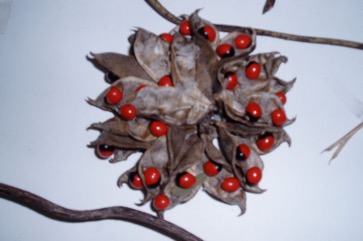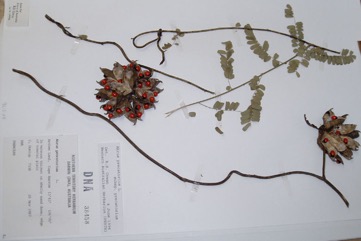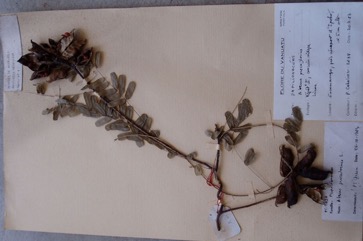Bird's eye, Indian liquorice

It is a tropical plant. It will grow on most soils but often occurs in sandy positions. It suits areas with a high rainfall and does best in sunny positions. It is damaged by drought and frost. They are widely distributed in areas of shrub throughout the Philippines. In Papua New Guinea it grows near mangroves. In Papua New Guinea they grow up to 660 m altitude. It Africa it grows up to 1,350 m above sea level. It needs a temperature above 16°C. It can grow in arid places.
Also known as:
Akarunga, Chanothi, Chek-awn, Chuselok, Crab’s Eye vine, Ghuguchi, Gidee Gidee, Gomchi, Guluganji, Gunchi, Gunj, Gunja, Gundu-mani, Gunja, Gurunginia, Jequirity Bean, Kansasaga, Kelimiefitra, Kulales halom tano, Kunch, Kunni, Masokoaky, Matamoso, Ngenguba, Ojos de cangrejo, Peronias, Prayerbead, Rati, Ratti, Rosary Pea, Tanuve, Wild licorice, Yerra gurija, Ywe, Ywe-nge, Ywe-nwe
Synonyms
- Glycine abrus L.
Edible Portion
- Seeds (POISONOUS) , Roots, Leaves
Where does Bird's eye grow?
Found in: Africa, American Samoa, Andamans, Angola, Asia, Australia, Benin, Botswana, Burkina Faso, Cameroon, Cape Verde, Central Africa, Chad, China, Chuuk, Congo DR, Côte d'Ivoire, East Africa, East Timor, Egypt, Eswatini, Ethiopia, Fiji, FSM, Ghana, Grenada, Guiana, Guianas, Guinea, Guinée, Guinea-Bissau, Guyana, Haiti, Hawaii, Himalayas, India, Indochina, Indonesia, Ivory Coast, Kenya, Laos, Liberia, Madagascar, Malawi, Mali, Marianas, Marquesas, Mozambique, Myanmar, Namibia, Nepal, Niger, Nigeria, North Africa, Northeastern India, Pacific, Pakistan, Papua New Guinea, PNG, Philippines, Puerto Rico, Rotuma, SE Asia, Senegal, Sierra Leone, Somalia, Southern Africa, South America, St Lucia, Swaziland, Sudan, Suriname, Taiwan, Tanzania, Timor-Leste, Tonga, Torres Strait, Turks & Caicos, Uganda, United States, Venezuela, Vietnam, West Africa, Zambia, Zimbabwe
Notes: There are about 26 Abrus species. The seeds are very poisonous. The roots, leaves and seeds have been used medicinally. It can become an invasive plant. The roots and leaves contain glycrrhizine that is in liquorice.
Status: Not known to be used as food in Papua New Guinea. A very minor food plant.
Growing Bird's eye, Indian liquorice
Cultivation: It is grown from seed. The seed need to be treated to break the dormancy. Putting them in boiling water can do this. Plants can also be grown from cuttings.
Edible Uses: CAUTION Seeds are very poisonous. They contain a poison called abrin. If chewed they can cause blindness and death. Roots are reported to be eaten in India. They are boiled and eaten in the Andaman Islands. They are a substitute for liquorice. The seeds have been recorded as eaten in Egypt and India after very long cooking. The leaves have been recorded as being used to make tea drinks in Australia. The very young leaves are cooked and eaten in Nepal when other food is scarce. The dry leaves are chewed with the leaves used with betel nut. The pods are recorded as roasted and eaten in the Andaman Islands.
Production: Plants flower in January to April in the southern hemisphere. The fruit develops from December to August. The young leaves are picked off.
Nutrition Info
per 100g edible portion| Edible Part | Energy (kcal) | Protein (g) | Iron (mg) | Vitamin A (ug) | Vitamin c (mg) | Zinc (mg) | % Water |
|---|---|---|---|---|---|---|---|
| Seeds boiled | - | - | - | - | - | - | |
| Root | - | - | - | - | - | - | |
| Leaves - tea | - | - | - | - | - | - | |
| Leaves | 62 | 5.6 | - | - | - | - | 79 |
Bird's eye, Indian liquorice Photos



References
Agea, J. G., et al 2011, Wild and Semi-wild Food Plants of Bunyoro-Kitara Kingdom of Uganda: etc. Environmental Research Journal 5(2) 74-86
Ambasta S.P. (Ed.), 2000, The Useful Plants of India. CSIR India. p 3
Bhardwaj, J. & Seth, M. K., 2017, Edible wild plant resources of Bilaspur, Hamirpur and Una districts of Himachal Pradesh, India. International Journal of Botany Studies. Volume 2; Issue 6; p 09-17
Bircher, A. G. & Bircher, W. H., 2000, Encyclopedia of Fruit Trees and Edible Flowering Plants in Egypt and the Subtropics. AUC Press. p 3
Bhargava, N., 1983, Ethnobotanical Studies of the Tribes of Andaman and Nicobar Islands, India. 1. Onge. Economic Botany 37(1): 110-119
Bodkin, F., 1991, Encyclopedia Botanica. Cornstalk publishing, p 5
Borrell, O.W., 1989, An Annotated Checklist of the Flora of Kairiru Island, New Guinea. Marcellin College, Victoria Australia. p 89
Bremness, L., 1994, Herbs. Collins Eyewitness Handbooks. Harper Collins. p 276
Brock, J., 1993, Native Plants of Northern Australia, Reed. p 54
Brown, D., 2002, The Royal Horticultural Society encyclopedia of Herbs and their uses. DK Books. p 97
Burkill, H. M., 1985, The useful plants of west tropical Africa, Vol. 4. Kew. (As subsp. africanus)
Burkill, I.H., 1966, A Dictionary of the Economic Products of the Malay Peninsula. Ministry of Agriculture and Cooperatives, Kuala Lumpur, Malaysia. Vol 1 (A-H) p 4
Busson, 1965,
Chandrakumar, P., et al, 2015, Ethnobotanical studies of wild edible plants of Gond, Halba and Kawar tribes of Salekasa Taluka, Gondia District, Maharashtra State, India. International Research Journal of Pharmacy 6(8)
Cooper, W. and Cooper, W., 2004, Fruits of the Australian Tropical Rainforest. Nokomis Editions, Victoria, Australia. p 200
Cowie, I, 2006, A Survey of Flora and vegetation of the proposed Jaco-Tutuala-Lore National Park. Timor-Lests (East Timor) www.territorystories.nt/gov.au p 47
Cundall, P., (ed.), 2004, Gardening Australia: flora: the gardener's bible. ABC Books. p 70
Datar, M. N. & Upadhye, A. S., 2016, Forest foods of northern region of Western Ghats. MACS - Agharkar Research Institute, Pune. Pp 1-160. ISBN: 978-93-85735-10-3 p 15
Dobriyal, M. J. R. & Dobriyal, R., 2014, Non Wood Forest Produce an Option for Ethnic Food and Nutritional Security in India. Int. J. of Usuf. Mngt. 15(1):17-37
Elliot, W.R., & Jones, D.L., 1982, Encyclopedia of Australian Plants suitable for cultivation. Vol 2. Lothian. p 6
Food Composition Tables for use in Africa FAO http://www.fao.org/n Herbarium. p 416
Glew, R. H., et al, 2010, The Amino Acid, Mineral and Fatty Acid Content of Three Species of Human Plant Foods in Cameroon. Food 4(1):1-6
Gul, M. Z., et al, 2013, Antioxidant and antiproliferative activites of Abrus precatorius leaf extracts- an in vitro study. Complementary & Alternative Medicine. 13:53
Jadhav, R., et al, 2015, Forest Foods of Northern Western Ghats: Mode of Consumption, Nutrition and Availability. Asian Agri-History Vol. 19, No. 4: 293-317
Kar, A., & Borthakur, S. K., 2008, Wild vegetables of Karbi - Anglong district, Assam, Natural Product Radiance, Vol. 7(5), pp 448-460
Kumar, A., 2013, Ethnobotanical study of wild vegetables used by rural communities of Kannauj district, Uttar Pradesh, India. Emir. J. Food Agric. 2013. 25 (10): 760-766
Latham, P., 2004, Useful Plants of Bas-Congo province. DFID p 9
Latham, P. & Mbuta, A. K., 2017, Plants of Kongo Central Province, Democratic Republic of Congo. 3rd ed p 11
Lulekal, E., et al, 2011, Wild edible plants in Ethiopia: a review on their potential to combat food insecurity. afrika focus — Volume 24, Nr. 2, 2011 — pp. 71-121
Melzer, R. & Plumb, J., 2011, Plants of Capricornia. Belgamba, Rockhampton. p 365
Mua Bioversity Profile, 2013, Profile for Management of the Habitats and Related Ecological and Cultural Resources of Mua Island. Torres Strait Regional Authority Land & Sea Management Unit. p 142
Narayanan Ratheesh, M. K. et al, 2011, Wild edible plants used by the Kattunaikka, Paniya and Kuruma tribes of Wayanad District, Kerala, India. Journal of Medicinal Plants Research Vol. 5(15), pp. 3520-3529
Peekel, P.G., 1984, (Translation E.E.Henty), Flora of the Bismarck Archipelago for Naturalists, Division of Botany, Lae, PNG. p 245, 244
Peters, C. R., O'Brien, E. M., and Drummond, R.B., 1992, Edible Wild plants of Sub-saharan Africa. Kew. p 130
Pham-Hoang Ho, 1999, An Illustrated Flora of Vietnam. Nha Xuat Ban Tre. p 890
Plants of Haiti Smithsonian Institute http://botany.si.edu/antilles/West Indies
Recher, P, 2001, Fruit Spirit Botanical Gardens Plant Index. www.nrg.com.au/~recher/ seedlist.html p 4
Reddy, K. N., et al, 2006, Traditional knowledge on wild food plants in Andhra Pradesh. Indian Journal of Traditional Knowledge 6(1) pp 223-229
Roodt, V., 1998, Common Wild Flowers of the Okavango Delta. Medicinal Uses and Nutritional value. The Shell Field Guide Series: Part 2. Shell Botswana. p 83
Royal Botanic Gardens, Kew (1999). Survey of Economic Plants for Arid and Semi-Arid Lands (SEPASAL) database. Published on the Internet; http://www.rbgkew.org.uk/ceb/sepasal/internet [Accessed 28th April 2011]
Scarth-Johnson, V., 2000, National Treasures. Flowering Plants of Cooktown and Northern Australia. Vera Scarth-Johnson Gallery Association. Cooktown, Australia. p 127
Seidemann J., 2005, World Spice Plants. Economic Usage, Botany, Taxonomy. Springer. p 2
Shah, G.L. et al, 1981, An account of the Ethnobotany of Saurashtra in Gujarat State (India). J. Econ. Tax. Bot. Vol 2 pp 173-182
Staples, G.W. and Herbst, D.R., 2005, A tropical Garden Flora. Bishop Museum Press, Honolulu, Hawaii. p 330
Syst. nat. ed. 12, 2:472. 1767
Townsend, K., 1994, Across the Top. Gardening with Australian Plants in the tropics. Society for Growing Australian Plants, Townsville Branch Inc. p 46
Townsend, K., 1999, Field Guide to Plants of the Dry Tropics. Society for Growing Australian Plants, Townsville Branch Inc. p 138
VAN ETTEN et al.,
Verdcourt, B., 1979, Manual of New Guinea Legumes. Botany Bulletin No 11, Division of Botany, Lae, Papua New Guinea. p 305
WATT
Wheeler, J.R.(ed.), 1992, Flora of the Kimberley Region. CALM, Western Australian Herbarium, p 365
Wightman, G. M. & Andrews, M.R., 1989, Plants of Northern Territory Monsoon Vine Forests (Vol 1). Conservation Commission of Northern Territory. p 112
Wightman, G. & Brown, J., 1994, Jawoyn Plant Identikit, Common Useful Plants in the Katherine Area of Northern Australia. Conservation Commission Northern Territory. p 54
Williamson, J., 2005, Useful Plants of Malawi. 3rd. Edition. Mdadzi Book Trust. p 9
Wilson, S., 1997, Some Plants are Poisonous. Reed. p 3
Yuncker, T.G., 1959, Plants of Tonga, Bernice P. Bishop Museum, Hawaii, Bulletin 220. p 144atabase. Published on the Internet; http://www.rbgkew.org.uk/ceb/sepasal/internet [Accessed 28th April 2011]
Scarth-Johnson, V., 2000, National Treasures. Flowering Plants of Cooktown and Northern Australia. Vera Scarth-Johnson Gallery Association. Cooktown, Australia. p 127
Shah, G.L. et al, 1981, An account of the Ethnobotany of Saurashtra in Gujarat State (India). J. Econ. Tax. Bot. Vol 2 pp 173-182
Staples, G.W. and Herbst, D.R., 2005, A tropical Garden Flora. Bishop Museum Press, Honolulu, Hawaii. p 330
Syst. nat. ed. 12, 2:472. 1767
Townsend, K., 1994, Across the Top. Gardening with Australian Plants in the tropics. Society for Growing Australian Plants, Townsville Branch Inc. p 46
Townsend, K., 1999, Field Guide to Plants of the Dry Tropics. Society for Growing Australian Plants, Townsville Branch Inc. p 138
VAN ETTEN et al.,
Verdcourt, B., 1979, Manual of New Guinea Legumes. Botany Bulletin No 11, Division of Botany, Lae, Papua New Guinea. p 305
WATT
Wheeler, J.R.(ed.), 1992, Flora of the Kimberley Region. CALM, Western Australian Herbarium, p 365
Wightman, G. M. & Andrews, M.R., 1989, Plants of Northern Territory Monsoon Vine Forests (Vol 1). Conservation Commission of Northern Territory. p 112
Wightman, G. & Brown, J., 1994, Jawoyn Plant Identikit, Common Useful Plants in the Katherine Area of Northern Australia. Conservation Commission Northern Territory. p 54
Wild edible plants of Himachal Pradesh
Williamson, J., 2005, Useful Plants of Malawi. 3rd. Edition. Mdadzi Book Trust. p 9
Wilson, S., 1997, Some Plants are Poisonous. Reed. p 3
World Checklist of Useful Plant Species 2020. Royal Botanic Gardens, Kew
Yuncker, T.G., 1959, Plants of Tonga, Bernice P. Bishop Museum, Hawaii, Bulletin 220. p 144